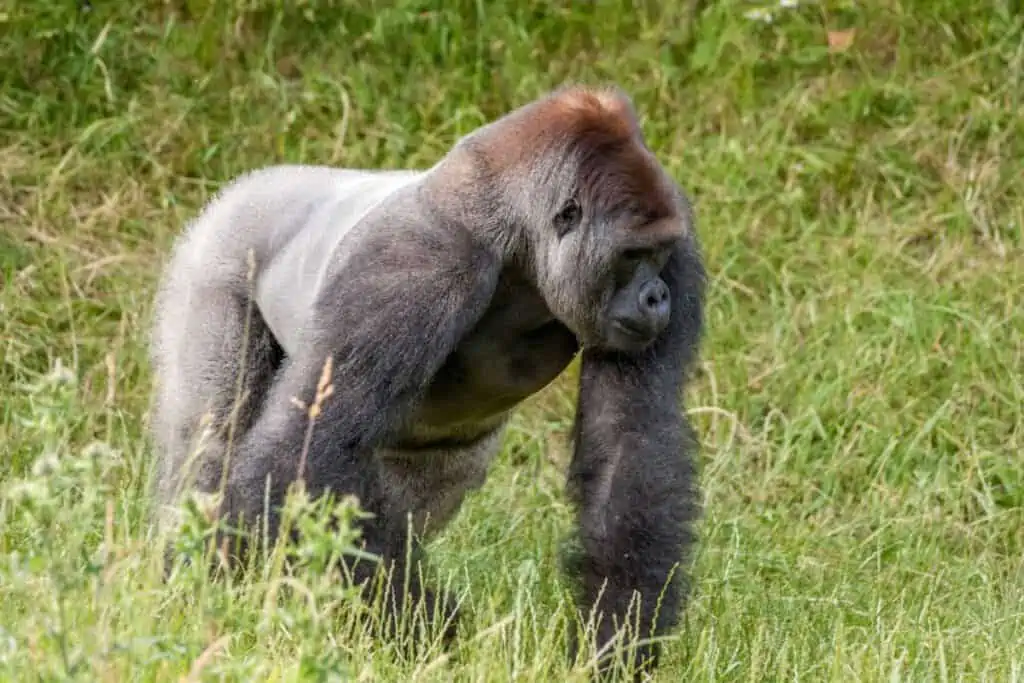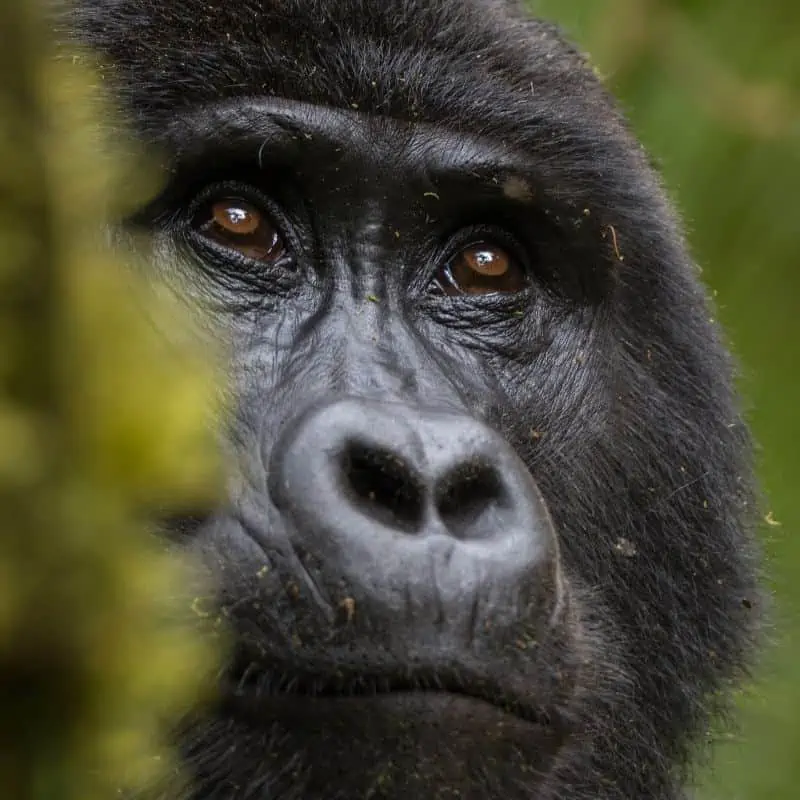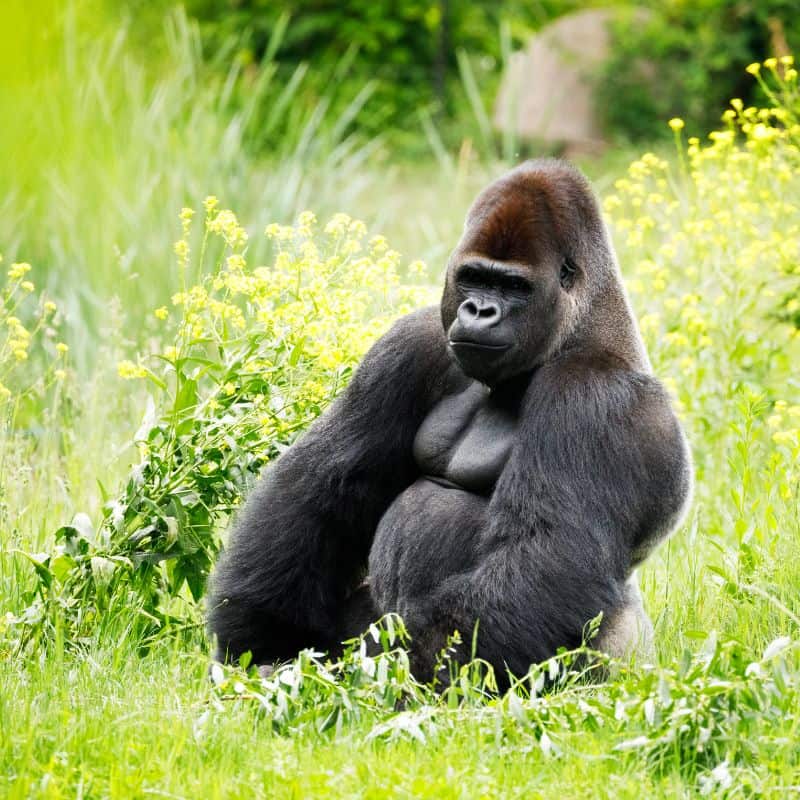Gorillas are intelligent creatures with remarkable communication skills. Gorillas can make 25 different sounds, and some gorillas have been able to learn sign language. These beautiful creatures inhibit lush tropical forests and show distinct signs of aging, but how long do gorillas live?
Most gorillas live until they are between 35 and 40 years old. Female gorillas have a longer lifespan; most females can reach 43 years old. Gorillas in captivity live longer than those in the wild, and in captivity, they can easily reach 50 years old.
Much like humans, gorillas start to show signs of aging from 35 years old. Gorillas are also susceptible to arthritis and teeth loss. As they age, the gorilla troop will take care of the elderly.
When a gorilla has reached the end of its life, it will often leave the troop to die alone. When a gorilla dies, the troop will mourn the loss of the gorilla.
How long can gorillas live?
There are two gorilla species, namely the eastern and the western gorilla. These species are further divided into five subspecies. The eastern gorilla has darker fur and a few more morphological features than the western gorilla.
Both gorilla species live in tropical or subtropical forests and haven’t shown much difference in how long they can live.
The longevity of Gorillas has only been studied since 1967, so the data on the life expectancy of Gorillas living in the wild is limited.
In the wild, some gorillas may only live up to 20 years old, while others may reach 40 years old. In captivity, gorillas tend to live much longer.
In the wild, gorillas are more susceptible to predators and poaching, which shortens their lifespan.

How old is the oldest living gorilla?
When gorillas live in captivity, they tend to live longer. It is possible for gorillas in the wild to live longer, but this is rarer.
Currently, the oldest living gorilla is a gorilla named Fatou, who lives at the Berlin Zoo in Germany. On the 22nd of April 2022, she celebrated her 65th birthday.
There have been a few other gorillas that have reached an impressive age; these include:
- Trudy lived until the age of 63 at Little Rock Zoo.
- Ozzie lives at Zoo Atlanta and will celebrate his 61st birthday in June 2022.
- Choomba, a female gorilla living at Zoo Atlanta, lived until she was 59.
What affects the lifespan of gorillas?
In ideal conditions, a gorilla can live for many years; however, factors like poaching, the destruction of a gorilla’s natural habitat, and predators influence the longevity of gorillas.
Gorillas are also critically endangered, and humans are the greatest threat to the gorilla population.
The following factors impact the lifespan of gorillas:
Predators
Humans remain the primary threat to gorillas, but leopards and crocodiles may also prey on gorillas.
Leopards rarely look for gorillas to prey on, but if they do, they prefer targeting the western lowland gorillas but avoid the silverback gorillas due to their strength and size.
Poaching
Poaching has a severe impact on the gorilla population.
Gorillas are poached for three main reasons; trophies, meat, and captured for collections.
Gorillas are often poached for trophies, and their hands, feet, skulls, and skins are mainly collected as trophies. Infant gorillas are also poached to sell in the illegal pet trade.
Finally, sometimes gorillas are also poached to be used as medicine.

Destruction of natural habitats
Coltan mining is a big reason why the natural habitats of gorillas are destroyed. This rare mineral is used in capacitors that regulate the current in the circuit boards of phones.
Most of this mineral is found in Africa, where most of the Gorilla population is also found.
There are very few alternatives for this mineral, making it even more sought after and intensely mined.
When mining for this mineral, most of the gorilla’s habitat is cleared, including most of their food sources. Mining leaves gorillas in great danger of starvation and left with no place to build homes and hide from poachers and hunters.
Gorillas also face habitat loss due to clearing land for agricultural purposes, building more homes, and creating space for cattle to graze.
Another big reason for the decline in the gorilla population is their habitats are used as a retreat during political unrest. Many armed forces hide in the dense jungle where gorillas live, forcing the gorillas to relocate and find another suitable habitat.
Bushmeat
Unfortunately, in the forests where gorillas are found, they are often hunted as bushmeat. Bushmeat is sold to low-income families and has become a profitable business for individuals, and is estimated to generate about $50 million annually.
The bushmeat industry is also thriving due to the destruction of the gorilla’s natural habitat and the increased infrastructure, making it easier for hunters to hunt this endangered species. With the growth in this bushmeat industry, the gorilla population is expected to be extinct within 5 to 15 years.
Disease
Some of the diseases that affect humans also affect gorillas.
These diseases are often found in soil and fecal matter. These diseases can live for six months, including tapeworm, tuberculosis bacillus, hepatitis A, and poliovirus.
How long do gorillas live in captivity?
Koko was one of the most well-known gorillas kept in captivity and was known to have mastered sign language.
Koko lived until 46, but many gorillas kept in captivity are known to live to an average of 50 years.
Currently, gorillas are living longer; some even reach 60 years old.
How long can gorillas live in the wild?
Gorillas are infants until they reach three and a half years old and are adults at around 8 or 9 years old.
In ideal conditions, a gorilla can reach 40 years old in the wild. However, deforestation, the destruction of a gorilla’s habitat, and predators affect the lifespan of gorillas.

Do all species of gorillas live longer in captivity?
Most species of gorillas thrive in captivity if cared for properly. However, in some instances, a gorilla’s personality can make it challenging to adapt to their new environment when in captivity, especially if they are introduced into captivity when they reach adulthood.
Mountain gorillas are a species that are not able to live in captivity. Mountain gorillas reside in central east Africa. During the 1960s and 1970s, a few attempts were made to introduce this gorilla species into captivity, but sadly these gorillas failed to survive.
The reason why mountain gorillas fail to thrive in captivity remains relatively unknown, but the likely cause is their need for a complex diet. Mountain gorillas live in high-altitude areas at elevations between 8,000 and 13,000 feet, where there aren’t many fruit trees, and most of their diet consists of stems, leaves, and buds.
Mountain gorillas consume plant matter from more than 142 species of plants. As a result, mountain gorillas rarely need to drink water and get most of the water from the plants they consume.
Mountain gorillas are also extremely rare, and it is believed that there are only about 1,063 mountain gorillas left.
These gorillas live between 35 and 40 years in the wild, but some mountain gorillas, primarily females, have longer lifespans.
Final thoughts on how long gorillas live
Many factors influence how long gorillas live. Many gorillas reach 35-40 years, while others in captivity have gotten as old as 60.
Unfortunately, humans are still one of the greatest threats to the gorilla population.
Although many conservation efforts are made to protect these species, gorillas remain on the critically endangered list.
